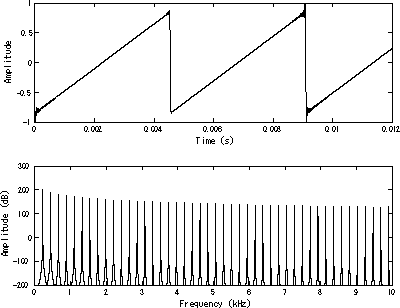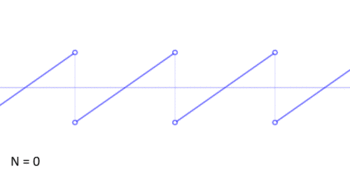Sawtooth wave

The sawtooth wave (or saw wave) is a kind of non-sinusoidal waveform. It is so named based on its resemblance to the teeth of a saw.
The convention is that a sawtooth wave ramps upward and then sharply drops. However, in a "reverse (or inverse) sawtooth wave", the wave ramps downward and then sharply rises. It can also be considered the extreme case of an asymmetric triangle wave.[1]
based on the floor function of time t is an example of a sawtooth wave with period 1.
A more general form, in the range −1 to 1, and with period a, is
This sawtooth function has the same phase as the sine function.
Another function in trigonometric terms with period p and amplitude a:
While a square wave is constructed from only odd harmonics, a sawtooth wave's sound is harsh and clear and its spectrum contains both even and odd harmonics of the fundamental frequency. Because it contains all the integer harmonics, it is one of the best waveforms to use for subtractive synthesis of musical sounds, particularly bowed string instruments like violins and cellos, since the slip-stick behavior of the bow drives the strings with a sawtooth-like motion.[2]
 |
Additive Sawtooth Demo
220Hz Sawtooth wave created by harmonics added every second over sine wave. |
| Problems playing this file? See media help. | |
A sawtooth can be constructed using additive synthesis. The infinite Fourier series
converges to a reverse (inverse) sawtooth wave. A conventional sawtooth can be constructed using
Where A is amplitude.
In digital synthesis, these series are only summed over k such that the highest harmonic, Nmax, is less than the Nyquist frequency (half the sampling frequency). This summation can generally be more efficiently calculated with a fast Fourier transform. If the waveform is digitally created directly in the time domain using a non-bandlimited form, such as y = x - floor(x), infinite harmonics are sampled and the resulting tone contains aliasing distortion.

An audio demonstration of a sawtooth played at 440 Hz (A4) and 880 Hz (A5) and 1760 Hz (A6) is available below. Both bandlimited (non-aliased) and aliased tones are presented.
 |
Sawtooth aliasing demo
Sawtooth waves played bandlimited and aliased at 440 Hz, 880 Hz, and 1760 Hz |
| Problems playing this file? See media help. | |
Applications
- Sawtooth waves are known for their use in music. The sawtooth and square waves are common starting points used to create sounds with subtractive analog and virtual analog music synthesizers.
- The sawtooth wave is the form of the vertical and horizontal deflection signals used to generate a raster on CRT-based television or monitor screens. Oscilloscopes also use a sawtooth wave for their horizontal deflection, though they typically use electrostatic deflection.
- On the wave's "ramp", the magnetic field produced by the deflection yoke drags the electron beam across the face of the CRT, creating a scan line.
- On the wave's "cliff", the magnetic field suddenly collapses, causing the electron beam to return to its resting position as quickly as possible.
- The voltage applied to the deflection yoke is adjusted by various means (transformers, capacitors, center-tapped windings) so that the half-way voltage on the sawtooth's cliff is at the zero mark, meaning that a negative voltage will cause deflection in one direction, and a positive voltage deflection in the other; thus, a center-mounted deflection yoke can use the whole screen area to depict a trace. Frequency is 15.734 kHz on NTSC, 15.625 kHz for PAL and SECAM).
- The vertical deflection system operates the same way as the horizontal, though at a much lower frequency (59.94 Hz on NTSC, 50 Hz for PAL and SECAM).
- The ramp portion of the wave must appear as a straight line. If otherwise, it indicates that the voltage isn't increasing linearly, and therefore that the magnetic field produced by the deflection yoke is not linear. As a result, the electron beam will accelerate during the non-linear portions. This would result in a television image "squished" in the direction of the non-linearity. Extreme cases will show marked brightness increases, since the electron beam spends more time on that side of the picture.
- The first television receivers had controls allowing users to adjust the picture's vertical or horizontal linearity. Such controls were not present on later sets as the stability of electronic components had improved.
See also
References
- ↑ "Fourier Series-Triangle Wave - from Wolfram MathWorld". Mathworld.wolfram.com. 2012-07-02. Retrieved 2012-07-11.
- ↑ http://homepages.abdn.ac.uk/mth192/pages/html/music.pdf page 42
External links
- Hugh L. Montgomery; Robert C. Vaughan (2007). Multiplicative number theory I. Classical theory. Cambridge tracts in advanced mathematics 97. pp. 536–537. ISBN 0-521-84903-9.






